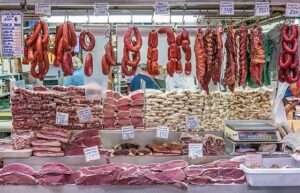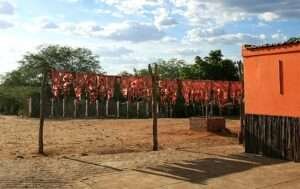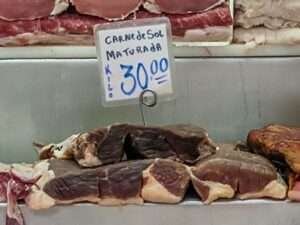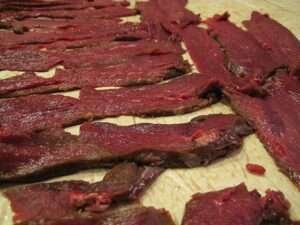In Brazil’s vast culinary landscape, few ingredients carry as much history, flavor, and regional identity as carne seca, carne de sol, and charque. These preserved meats were born from necessity but have become essential components of beloved Brazilian dishes across different regions. While they share similarities, their preparation, texture, flavor, and cultural roles are distinct—and understanding those differences helps us appreciate Brazilian cuisine on a deeper level.

at São Paulo Farmers Market! the biggest and most famous open market in South America
What Are They?
Carne Seca (Dried Beef)
Carne seca is a deeply salted and sun-dried beef, preserved for long periods. It’s tough and intense in flavor, traditionally used in stews and casseroles.

Carne de Sol (Sun-Cured Beef)
Carne de sol is a lightly salted and quickly air-cured beef, meant to be eaten within a few days. It retains moisture, has a tender texture, and isgrilled or fried in many Northeastern dishes.

Charque (Salted Jerky)
Charque is a more industrialized, standardized version of carne seca, with thinner cuts, heavy salting, and deeper drying. It originated in Southern Brazil and was historically used to feed armies, ship crews, and rural workers.

A Brief History
Preserving meat through salting and drying dates back centuries and was especially important in a country with tropical heat and no refrigeration. Portuguese settlers broughtpreservation techniques, but it was Brazilian ingenuity—especially in the Northeast (sertão) and South (pampas)—that adapted these techniques to local conditions.
-
Carne de sol is deeply rooted in Northeastern rural culture, where ranchers and cowboys (vaqueiros) would hang meat under covered porches, using shade and dry air to gently cure it.
-
Carne seca and charque became trade commodities. Charqueadas (meat salting plants) boomed in the 18th and 19th centuries, especially in Rio Grande do Sul, helping feed enslaved workers and entire cities.
Even today, these preserved meats are more than culinary tools—they’re symbols of survival, tradition, and creativity.
Regional Use & Cultural Significance
-
Carne de Sol is iconic in Northeastern Brazil (Bahia, Pernambuco, Rio Grande do Norte, Ceará). It’s served in homes and high-end restaurants alike, often accompanied by cassava, beans, and manteiga de garrafa (bottled butter).
-
Carne Seca is widespread in Southeastern and Northern Brazil. Its strong flavor holds up in hearty dishes like feijoada or escondidinho (Brazilian shepherd’s pie).
-
Charque is mostassociated with Southern Brazil, especially in Gaucho cuisine, appearing in dishes like arroz de carreteiro (cowboy rice).
How to Make Each Type from Fresh Meat (Using 2kg)
How to Make Carne de Sol (Light-Cured Beef)
You’ll need:
-
2kg of beef (sirloin, rump, or chuck, cut into 2 large slabs)
-
60g of coarse salt (about 3% of meat weight)
- 30g of brown sugar (about 1.5% of meat weight)
Steps:
-
Rub the salt evenly over the meat.
-
Place the meat on a wire rack or tray with drainage. Cover loosely with a cloth or mesh to protect from insects.
-
Store it in a ventilated, shaded place (not under direct sun) for 24 to 36 hours, turning the meat every 8-12 hours.
-
After this period, rinse gently under cold water to remove excess salt.
-
Store in the fridge and use within 3–5 days, or freeze.
Tips:
-
If the meat feelsleathery but still moist inside, it’s perfect.
-
Avoid oversalting—it should preserve, not overwhelm the natural flavor.
-
A fan or breezy environment helps the drying process.
How to Make Carne Seca (Dried Beef)
You’ll need:
-
2kg of beef (preferably flank, top round, or brisket)
-
120g of coarse salt (6% of meat weight)
Steps:
-
Salt the meat heavily and place in a covered container for 48 hours, turning halfway through.
-
After curing, rinse off the excess salt and hang or lay the meat in full sun, covered with a mesh, for 3 to 5 days, bringing it in at night to avoid moisture.
-
The meat should become firm and dry to the touch but not brittle.
-
Store in a cool dry place or refrigerate/freeze for longer shelf life.
Tips:
-
The meat should be dry and stiff but still pliable.
-
If humidity is high, use a dehydrator or low oven (50°C / 122°F) to assist drying.
-
Always desalt before cooking: soak in cold water for 12-24h, changing water a few times.
How to Make Charque (Southern-Style Jerky)
You’ll need:
-
2kg of lean beef, cut into thin strips (1.5–2 cm thick)
-
150g of coarse salt (7–8% of meat weight)
Steps:
-
Rub salt generously over each strip. Layer in a container and refrigerate for 72 hours, rotating daily.
-
Rinse quickly to remove excess salt and dry in direct sun or a dehydrator for 5 to 7 days, depending on humidity.
-
The meat should look dark, leathery, and dry—it can be stored for months in sealed containers.
Tips:
-
Charque should be fully dry and very salty.
-
Rehydrate and desalt before use.
-
Best used in dishes with long cooking times.
Authentic Recipes
Carne Seca Recipe: Brazilian Cassava & Dried Beef Casserole (Escondidinho)
Ingredients:
-
500g carne seca (soaked, cooked, and shredded)
-
1kg boiled cassava (yucca)
-
200ml milk
-
2 tbsp butter
-
1 onion, chopped
-
2 garlic cloves
-
Salt & pepper to taste
-
Grated cheese (coalho or mozzarella)
Instructions:
-
Sauté the shredded beef with garlic and onion.
-
Mash the cassava, then mix in butter and milk to form a smooth purée.
-
In a baking dish, layer half the cassava, all the beef, and the rest of the cassava. Top with cheese.
-
Bake until golden on top.
Curiosity: Escondidinho means “little hidden one,” as the meat is hidden between layers of cassava.
Carne de Sol Recipe: Baião de Dois (Rice & Beans with Sun-Cured Beef)
Ingredients:
-
300g carne de sol (soaked, cooked, and cubed)
-
1 cup white rice
-
1 cup cooked cowpeas or black-eyed peas
-
1 red onion, chopped
-
2 garlic cloves
-
2 tbsp manteiga de garrafa (or regular butter)
-
Chopped cilantro and scallions
-
Coalho cheese (optional)
Instructions:
-
Sauté the carne de sol in butter with onion and garlic.
-
Add the rice, stir well, and then add the beans and a bit of bean broth.
-
Cook until rice is tender. Add herbs and cheese at the end.
Curiosity: “Baião de Dois” is named after a musical rhythm (baião) and “two” (dois) for the pairing of rice and beans.
To close!
These three types of Brazilian preserved meats are not just culinary artifactsthey are historical testaments to survival, creativity, and regional pride. From sun-drenched porches in the sertão to gaucho kitchens in the South, carne de sol, carne seca, and charque continue to inspireBrazilian chefs and home cooks alike.
Whether you’re making a humble baião or a rich escondidinho, using these meats brings depth, authenticity, and tradition to the table.



